-
 7 min. read
7 min. read
-
 Trevin Shirey
Trevin Shirey VP of Marketing
VP of Marketing
- Trevin serves as the VP of Marketing at WebFX. He has worked on over 450 marketing campaigns and has been building websites for over 25 years. His work has been featured by Search Engine Land, USA Today, Fast Company and Inc.
Now that 86% of B2B marketers and 77% of B2C marketers use content marketing as part of their strategies for reaching new customers, there’s a wealth of branded content online. And although this is great news for consumers who are looking for useful product information, it means that it’s increasingly difficult for companies to stand out from their competitors. One of the best ways to cut through the noise is by creating original visual content.
Although filming videos and designing graphics may be a bit more work-intensive than writing articles and blog posts, they’ll allow your readers to process information faster and keep their attention. So if you don’t already use images and videos in your content marketing strategy, it’s time to start. And if you’re not sure what to create, the following five types are the best ways to begin.
Interesting infographics
One of the most common types of visual content marketing is infographics.
These graphics are typically used to explain a narrow topic or provide statistics on a specific subject, and businesses in virtually every industry use them to make data more accessible to readers. Earlier this year, for example, the WebFX team wanted to put together a blog post about the cost iPhones around the world. But instead of simply listing the prices in a table (which, quite frankly, would’ve been pretty boring), we created a map of where they’re sold and used different colors to indicate the relative cost:  The post earned us close to a hundred Tweets, over a thousand likes on Facebook, and a handful of links back to our site – not bad for a post about phone costs.
The post earned us close to a hundred Tweets, over a thousand likes on Facebook, and a handful of links back to our site – not bad for a post about phone costs.
So if you’re considering creating a data-heavy post (or have some interesting business stats you’d like to share), a custom infographic could be a great way to organize the information in a digestible way, have unique visual for your site, and possibly even boost your SEO.
How-to videos
If your business sells products that can be used in interesting ways, videos can be a fun method to give your customers ideas and guidance. Many companies are now using them as part of their marketing strategies with great success, and when it comes down to it, Internet users simply like videos. Kraft does a great job with this on their YouTube channel, which features short videos of simple recipes: 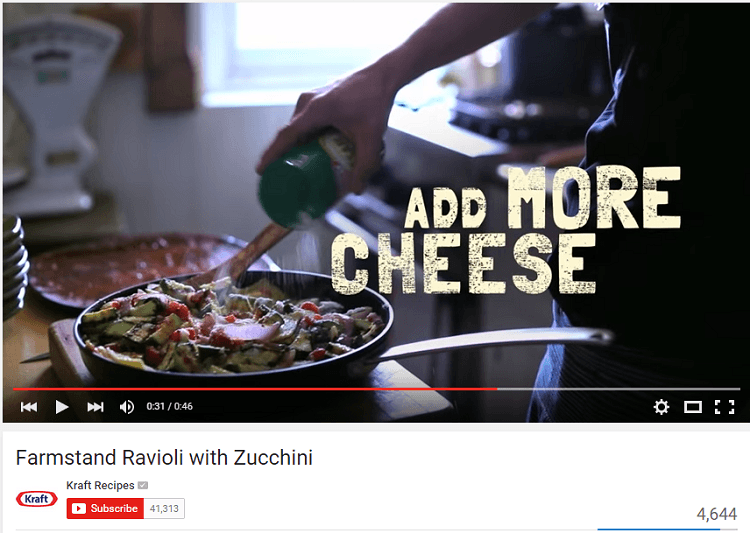 Watching them is much more interesting than reading a recipe, and they’re all simple enough that you don’t need to be a chef to make the food shown at home.
Watching them is much more interesting than reading a recipe, and they’re all simple enough that you don’t need to be a chef to make the food shown at home.
And of course, many of them feature the company’s products (like the Kraft grated parmesan above). However, they also offer more general videos, like “How to Shred Chicken” and “How to Cut an Avocado.” This not only makes for a more interesting channel, but also allows them the potential to rank for these terms in search engines like Google.
Original user content
If your customers are active on social media and love to show off your products, your company has a huge opportunity to benefit from user-generated content. Asking for photos and videos from the people who use your products not only provides you with a wealth of content, but also builds trust with potential customers.
Many brands use social media contests to ask for photos from their customers, like this one from Mountain Hardware: 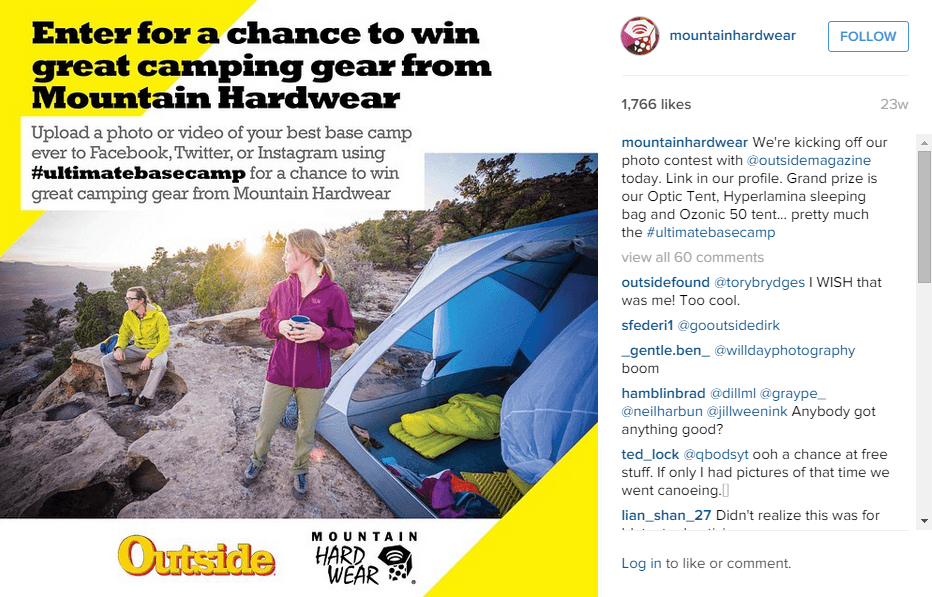 As a camping brand, it was safe for them to assume their customers would have photos of campsites and be interested in winning camping gear. And as a result, they earned several hundred entries from fans:
As a camping brand, it was safe for them to assume their customers would have photos of campsites and be interested in winning camping gear. And as a result, they earned several hundred entries from fans: 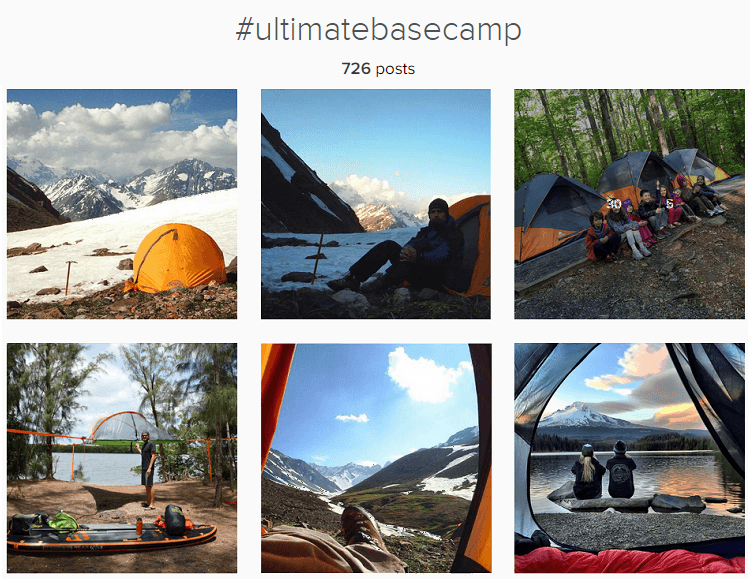 These all fit perfectly with the brand’s identify, and – with permission – could be used in a variety of different ways across their site. And even if you aren’t running a contest, happy customers will often want to share their purchases on social media.
These all fit perfectly with the brand’s identify, and – with permission – could be used in a variety of different ways across their site. And even if you aren’t running a contest, happy customers will often want to share their purchases on social media.
Create an official hashtag, and monitor it on a regular basis. Feetures, another company that asked for user-generated content and sells athletic socks, simply shows these posts right on their site: 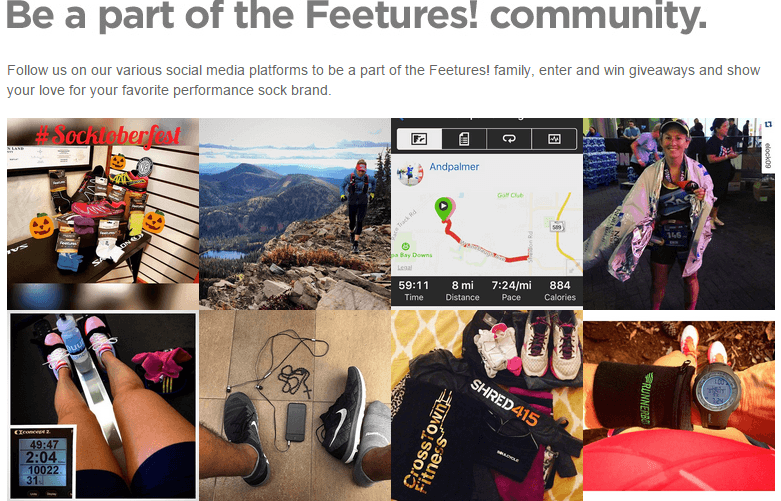 However, if you’re considering this strategy, I strongly recommend that you don’t just use an API for a real-time feed. Put an approval system in place, or you open your site up to all kinds of content – whether if fits your brand or not.
However, if you’re considering this strategy, I strongly recommend that you don’t just use an API for a real-time feed. Put an approval system in place, or you open your site up to all kinds of content – whether if fits your brand or not.
Even if you have the best customers in the world, there are always a few people on the Internet who can ruin it for everyone if you’re not careful.
Behind-the-scenes photos and videos
Many companies only show their polished and professional side on their site and social media. And while there’s something to be said for maintaining a certain image, many consumers like getting a more behind-the-scenes look at their favorite brands. Crayola, for example, uses video to give site visitors an inside look at their manufacturing process: 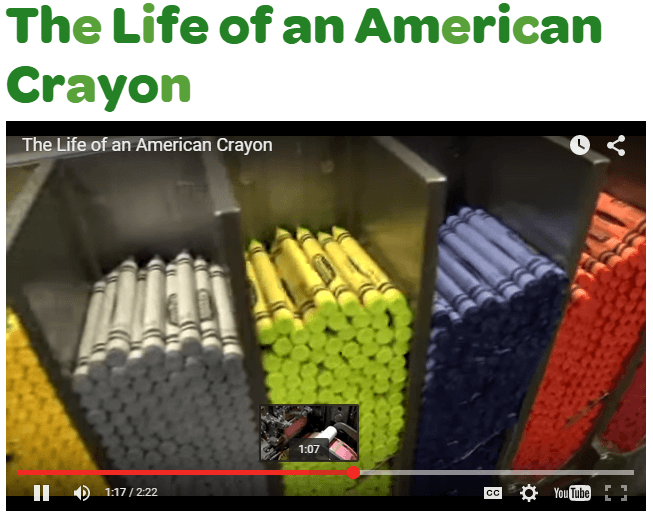 While running a crayon factory is certainly an advantage when it comes to interesting visuals, the video doesn’t stick to shots of the colorful art supplies being produced.
While running a crayon factory is certainly an advantage when it comes to interesting visuals, the video doesn’t stick to shots of the colorful art supplies being produced.
Instead, it includes one-on-one interviews with the employees who work there, which really helps humanize their brand. Even if your business’s day-to-day operations don’t seem particularly interesting or glamorous, this kind of content can help customers put faces to an otherwise abstract brand. Share photos of your team, create videos of what goes on in your workspace, and see how your customers respond.
Straightforward illustrations
In addition to creating visuals that stand as content all on their own, charts, graphs, and other illustrations can be helpful additions to your written content.
Creating them can be simple, too – like this one from Buffer’s blog: 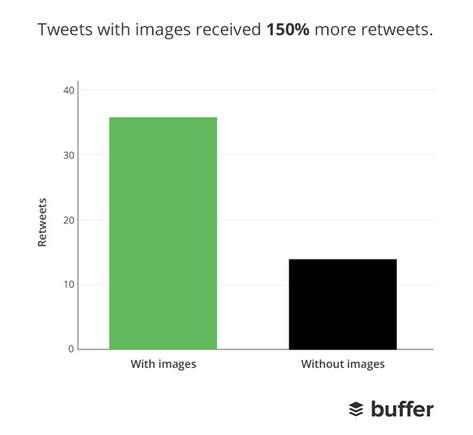 These not only add some visual interest but are also perfect for sharing on social media and linking back to your posts. And when you consider that according to the post this image came from, Tweets with images receive 18% more clicks, 89% more favorites, and 150% more retweets, that alone is a reason to start adding visuals to your posts.
These not only add some visual interest but are also perfect for sharing on social media and linking back to your posts. And when you consider that according to the post this image came from, Tweets with images receive 18% more clicks, 89% more favorites, and 150% more retweets, that alone is a reason to start adding visuals to your posts.
Start using visual content!
If images and videos don’t currently have a place in your content marketing strategy, you have a huge opportunity to help your customers better understand your industry and products. Start with the five types of content above, and let me know if you have any other suggestions in the comments below!
-
 Trevin serves as the VP of Marketing at WebFX. He has worked on over 450 marketing campaigns and has been building websites for over 25 years. His work has been featured by Search Engine Land, USA Today, Fast Company and Inc.
Trevin serves as the VP of Marketing at WebFX. He has worked on over 450 marketing campaigns and has been building websites for over 25 years. His work has been featured by Search Engine Land, USA Today, Fast Company and Inc. -

WebFX is a full-service marketing agency with 1,100+ client reviews and a 4.9-star rating on Clutch! Find out how our expert team and revenue-accelerating tech can drive results for you! Learn more
Try our free Marketing Calculator
Craft a tailored online marketing strategy! Utilize our free Internet marketing calculator for a custom plan based on your location, reach, timeframe, and budget.
Plan Your Marketing Budget

Maximize Your Marketing ROI
Claim your free eBook packed with proven strategies to boost your marketing efforts.
Get the GuideTry our free Marketing Calculator
Craft a tailored online marketing strategy! Utilize our free Internet marketing calculator for a custom plan based on your location, reach, timeframe, and budget.
Plan Your Marketing Budget





